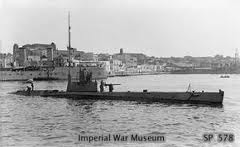- Author
- A.N. Other
- Subjects
- Biographies and personal histories, History - WW1
- Tags
-
- RAN Ships
- None noted.
- Publication
- September 2011 edition of the Naval Historical Review (all rights reserved)
By the late Captain W.J. Cowling, as told by his daughter Mrs C.M. Wood.
At the beginning of WWI the Royal Navy (RN) had 70 submarines in commission, which was the largest number of any of the Allied Powers. In comparison the United States Navy (USN) had 29 and the Imperial Germany Navy (IGN) 28 submarines in commission in 1914. The first five RN boats had been built by Vickers at Barrow under licence from the American Electric Boat Company. The RN boats commenced with the ‘A’ class dating from 1903 through a confusing array of letters to the ‘W’ class of 1914 and beyond. The ‘A’ to ‘E’ boats were all improved variants of the original American ‘Holland’ design. As part of a rapid expansion program with the onset of WWI the Admiralty ordered ten submarines based on the US Navy’s ‘H’ class, which, to circumvent American neutrality, were assembled in Canada. This article concerns H-12, built by the Canadian Fore River Shipbuilding Company in 1915. The navigator of H-12 was an Australian RNR officer Lieutenant W.J. Cowling. The story told by his daughter Mrs C.M. Wood was first published by the Shiplovers Society of Victoria in The Dog Watch No 33 in 1976. It has been reprinted with permission and subsequent minor editorial amendments. By coincidence, Albert Enos, the father of the Secretary of our Society, Robert Enos, was a master mariner who also served in the RNR as a navigator in a later generation ‘H’ boat, known as ‘Modified H’ boats which were British built from 1917 with some remaining in service until WWII.
This is Lieutenant Cowling’s story:
In early 1918, I applied, with the approval and recommendation of Commander Moss, to join the Submarine Service and in May of that year I was accepted for this Service, of which the personnel, both officers and men, was made up entirely of volunteers. If for any reason one felt it was not wise to remain in this branch of the Navy one could request a transfer back to general service and this transfer was granted immediately and without question. Before admittance, there was a strict medical examination to be passed. It was a Service for young men only; the officers were mostly the rank of Lieutenant RN or Lieutenant Commander RN while during the war a big proportion of the navigators, increasingly so as it dragged on, were Lieutenant RNR.
The British submariners had been long and thoroughly trained in peacetime to war conditions. Absolute understanding of the boats and machinery and of the job to be done was imperative for survival. One man’s mistake could cause the loss of both boat and crew, or at least jeopardise both. Discipline in all ranks, personal discipline of the highest order, was a necessity, yet the very nature of the manner in which submarine crew lived and worked brought about a less formal attitude between officers and men than in the surface craft. The seeming unconcern and even nonchalance of these men as they went about their tasks was the result of rigid training which time and again came to the fore in an emergency. With them, but not of them, I came to know and to admire their great qualities of absolute obedience and acceptance of responsibility. I always hoped that if things did not go well for us I would not be found wanting in such company.

Imperial War Museum
On 10 May 1918 I was appointed to the submarine depot ship HMS Maidstone for instruction and exercises. Maidstone, under the command of Captain S. Addison (who after WWI came to Australia in charge of the Australian Squadron) was based at Harwich situated amidst peaceful farmlands on the south bank of the River Stour in Essex. It was one of the most important bases on the east coast for our submarines patrolling the North Sea. Thousands of men connected with the Harwich Striking Force, the Submarine Flotillas and the Minesweepers operated from the base. Everything was done to make their off-duty time as pleasant as possible. One of the sheds on the wharf had been converted into a concert hall where once or twice a week a show was put on to entertain the crews based at Harwich. Artists came up from London and when these were not available the men themselves took over and presented some form of entertainment; it was surprising what talent came to the fore when called upon. We kicked the football and played a little cricket. Talks were given by well known personalities and on one such occasion Lord Frederic Hamilton gave us a very interesting address on his life in the Diplomatic Service. For those with two or three days leave, a visit to Ipswich, which was a fairly big provincial town – ‘going up to Switch’ as it was known – provided more sophisticated amusement than that obtained at Harwich.




